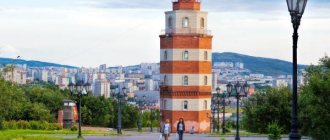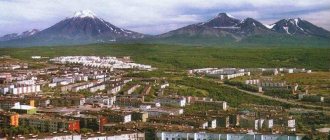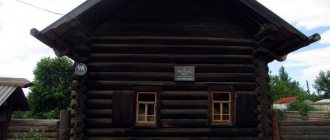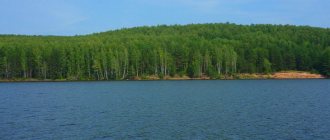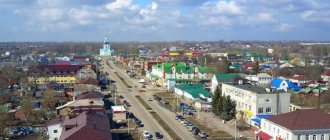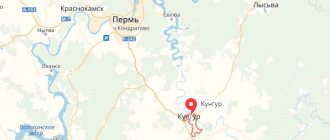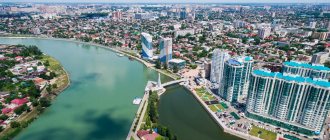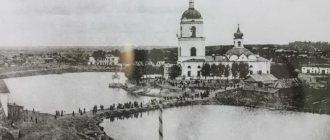You ask, is there life beyond the Arctic Circle? Yes, in the city of Murmansk , the administrative center of the region of the same name. The city is famous for the fact that it is three times the “most”: large, young and warm in the Arctic. And also - Murmansk residents love their city on the Kola Peninsula
- for the unique northern lights and youth
- rough sea and hills,
- special sunsets and sunrises, to
- arctic polar vegetation and the warm Gulf Stream,
- for the kindness and sincerity of the inhabitants of this harsh region.
The city of Murmansk is also famous for the fact that it is the last city where the imperial ambitions of the Romanov dynasty were realized. In 1916, the year of his formation, he was called, although only for a short time, Romanov-on-Murman. It received its modern name just 5 months after the bourgeois revolution.
There were no Bolsheviks in the city until the beginning of 1920 - all this time the northern port was under the rule of the rebellious Admiral Kolchak. A run-of-the-mill, provincial town with handicraftsmen and artisans who catch fish - that’s the entire population of two thousand people. And yet, the 20s became a turning point in the fate of the settlement - it began to develop as a strategic bridgehead-port in the north of the Soviet Union.
The fishing port is growing, and a railway connection with Leningrad has been established. By the beginning of the war there were already 120 thousand people in the city. During the war, the city was subjected to intense bombing, and by the time it ended it was completely destroyed, with the exception of the seaport and three buildings.
The Soviet government included it in the state program for the revival of fifteen cities. 100 million rubles allocated from the state treasury were used for the construction of industrial enterprises, berths along the coast of the Barents Sea, construction of housing and infrastructure. After the construction of their house-building plant, the delivery of housing increased significantly; brick housing construction was replaced with prefabricated panel housing.
Climate of the Kola Peninsula
The proximity of the Barents Sea has a direct impact on the climate of Murmansk, which differs significantly from other cities beyond the Arctic Circle.
In snowy January and February, the average air temperature is -10 °C. Its strong decrease in winter (to approximately – 35 °C) is observed extremely rarely. Warm air masses carried by the North Atlantic Current from time to time provoke thaws in Murmansk, and also delay the onset of cold weather for one month.
The average air temperature in summer is +12-13 °C, sometimes it reaches +25-30 °C. Most precipitation occurs from June to September.
In winter, the sun practically does not appear on the horizon. This phenomenon is called polar night. In summer, on the contrary, the sun does not set beyond the horizon during the day - it is a polar day in Murmansk.
Murmansk
Video: Murmansk
general information
The history, daily life and economy of Murmansk are connected with the sea, and this determines the appearance of the city. At the berths and on the roads of the Kola Bay at any time of the year you can see large and small ships flying the flags of various countries. Fishing fleets depart from the city port to fish in the Barents Sea, and then to the vast expanses of the North Atlantic. The city-forming enterprise of Murmansk is the Murmansk Sea Fishing Port, whose activities include fishing and processing of fish, as well as ship repair and sea transportation. Not only seafood, but also coal and metal are transported from here.
Murmansk is a fairly young city, there are no outstanding historical attractions, but it is impressively original. Tourists, domestic and foreign, often visit Murmansk, because it personifies the Russian North. In the city, located on squat hills, there are several iconic places - monuments, memorials associated with its heroic history. In the well-kept central area, guests are greeted by quite decent hotels and excellent restaurants where you can taste authentic dishes typical of this region.
Outside the city limits, a variety of northern landscapes opens up: tundra, taiga, mountains, fjords. Traveling to the kingdom of wild nature - with a guided tour or on your own - is invariably popular among inquisitive tourists.
The Northern Lights, which everyone dreams of seeing, can be observed in Murmansk not only during the winter polar nights, but also at other times of the year if the day turns out to be cold and clear. The polar night and polar day, which seem exotic to visitors, are commonplace for Murmansk residents, but they celebrate the change of seasons on a grand scale. The arrival of spring is marked by the festival “Hello, Sun”, in the summer the Murmansk Mile festival is held here, and in the winter the Festival of the North is celebrated, or, as it is called here, the Polar Olympics.
History of Murmansk
People began to settle on the Kola Peninsula long before the beginning of the new era. The earliest sites discovered here date back to the 9th-7th millennia BC. e. The indigenous inhabitants of the peninsula - the Sami (or Lapps) - settled here more than a thousand years ago. In the 11th-13th centuries, the Kola Peninsula was actively explored by pioneers from the Novgorod Republic. Initially, the Novgorodians equipped fishing expeditions to these regions, which were engaged in fishing and fur farming. Then settlements began to appear here. Mostly people settled in the lands near the White Sea, which they called the Icy Sea. On the shores of the Barents Sea, where modern Murmansk is located, the Pomors set up seasonal “trapping camps”. In 1478, the Kola Peninsula became part of the Moscow Principality.
At the end of the 19th century, the Russian government began to consider projects for the construction of a port in the Arctic and the construction of a railway leading to the northern borders of the empire, including the Kola Peninsula. The plans remained unrealized for a long time, but with the outbreak of the First World War they began to be rapidly implemented. This was due to the fact that communication across the Baltic Sea with the allies was interrupted, and the Arkhangelsk port, which was frozen for almost half a year, could not fully justify its strategic purpose. The ice-free Kola Bay of the Barents Sea turned out to be a suitable place for building a naval base.
At the end of 1914, it was decided to build a railway from Petrozavodsk to the coast of the Kola Peninsula. In the fall of 1916, shortly before the completion of work, a new Russian port was founded on the shore of an ice-free bay - Romanov-on-Murman. Murman has long been called the coast of the Barents Sea, and then the entire peninsula. The word “Murman,” as most historians believe, comes from “norman,” which translated from Scandinavian languages means “northern man, northerner.” The founding date of the city is considered to be October 4, 1916, when a temple was laid on one of the hills in the name of St. Nicholas, who protects seafarers. The new city was destined to become the last one founded in Tsarist Russia. After the February Revolution, it was renamed Murmansk.
In 1918, after the conclusion of the Brest-Litovsk Treaty, troops from French and British ships that had anchored in the Kola Bay before the February events landed in Murmansk. This was the beginning of the intervention. A year later, the Entente military was replaced by the Kolchakites, but already in February 1920 the Bolsheviks wrested power from them. The northern city developed rapidly, becoming a supply and ship repair base for ships of the Northern Fleet. The Murmansk port grew, from where fish was supplied to all regions of the USSR.
During World War II, Murmansk received convoys of ships from allied countries delivering cargo under Lend-Lease to assist our troops. Until now, every spring, veterans of the allied Polar convoys of World War II, their children, and relatives come to Murmansk to take part in ceremonies dedicated to Victory Day.
German troops persistently, but unsuccessfully, sought to capture the city, attacking it by land and from the air. As a result of the ongoing military operations, Murmansk was practically destroyed. All wooden buildings were burned, only the port structures, reliably guarded by air defense, and the central neighborhoods, built up with stone houses, survived. In 1945, the Soviet government included Murmansk among fifteen priority cities for restoration. By 1950, the task was successfully completed.
During the Soviet era, people from all over the Union came to Murmansk in search of well-paid work. Service in the military and merchant navy was considered prestigious. In the 1990s, Murmansk, like many cities in the country, experienced an economic crisis. The port's cargo turnover dropped sharply, the number of fishing vessels decreased, and an outflow of population began. At the same time, after the fall of the Iron Curtain, trade ties with their Scandinavian neighbors were gradually established. Today, Norwegian and Finnish ships are frequent guests in the city's port. Ships from Murmansk, in turn, regularly visit the harbors of their neighbors. The main item of commerce is fish. Recently, ecotourism has been developing rapidly in the Murmansk region, and the number of foreigners arriving here to discover the virgin corners of nature in the Far North of Russia is growing.
Geography
Murmansk occupies almost 150 km² of the Kola Peninsula, in its northeastern part. The city stretches for almost 20 km along the deep-water, ice-free Kola Bay. The port of Murmansk is separated from the access to the open waters of the Barents Sea by 25 nautical miles.
Murmansk is located almost 300 km north of the Arctic Circle, which runs almost along the border of Karelia and the Murmansk region, which are part of the Northwestern Federal District of the Russian Federation. The Murmansk region itself occupies the entire Kola Peninsula and adjacent areas of the mainland. In the west, it neighbors Norway and Finland, and across the White Sea, which washes the southern coast of the peninsula, with the Arkhangelsk region.
Murmansk is surrounded by low, up to 300 meters, hills covered with open forest, mainly dwarf birch trees and shrubs. Basically, the eastern part of the peninsula, to which Murmansk belongs, is flat, in places very swampy. The west is dominated by gentle hills and valleys. In the central part of the Kola Peninsula lie the majestic Khibiny mountain ranges (height up to 1200 m) and the Lovozero tundra (height up to 1120 m).
The main base of the Russian Northern Fleet is the city of Severomorsk, 16 km northeast of Murmansk. It has the status of a closed administrative-territorial entity (ZATO). Murmansk is separated from Moscow by 1,490 km, and from St. Petersburg by 1,020 km. Local time corresponds to Moscow.
Climate
The climate features of Murmansk are determined by the proximity of the Barents Sea - the marginal sea of the Arctic Ocean. Its water area near the Kola Peninsula is influenced by the warm North Atlantic Current, which is a continuation of the Gulf Stream. Thanks to this, the Barents Sea off the coast of the peninsula does not freeze and supplies shelf areas with heat in winter. Floating ice can be seen here only in extremely severe winters. In the entire history of hydrological observations, the Kola Bay itself has been frozen only a few times. This phenomenon was observed in particular in 1999, when frosts were severe in these parts. That winter, shipping here was paralyzed due to freezing. However, these are extremes, but in general Murmansk has the reputation of being the warmest and relatively comfortable city in the Arctic for living.
The weather in Murmansk is unpredictable. In different years, winters can be both very cold and relatively warm, and the amount of snow that falls varies from time to time. In the summer, frosts can hit here; it also happens that it snows in the morning, and in the afternoon it becomes really warm or even hot.
Winter in Murmansk is the longest season; it reigns here for more than six months - from October to April. The coldest months are January and February. The air temperature is not constant. Both during the day and at night it can range from –25 °C to –10 °C. The minimum temperature recorded here: –39.4 °C. Thaws also occur in Murmansk, but strong winds and high humidity even with slight frosts create discomfort.
In Murmansk, as elsewhere in the Far North, the polar night reigns in winter. Murmansk residents do not see the sun at all from December 2 to January 11, that is, a whole 42 days. Then the luminary is shown to people at first for several tens of minutes, but day by day the duration of daylight hours increases.
Spring comes to Murmansk at the end of April, the snow begins to melt. The snow usually completely melts within the city by the end of May, but in the surrounding areas it may not melt until the first half of June. On May 22, the polar day begins - for more than 50 days the sun does not set beyond the horizon, although it does not rise high. From the end of May, thanks to constant illumination, nature quickly begins to come to life.
Murmansk summer, that is, the period when the air temperature exceeds +10 °C, lasts from mid-June to mid-late August. The warmest month is July, at this time the air warms up to +18 °C during the day, and usually about +10 °C at night. The rainiest month is August. In summer there are frosts and even snowfalls. At the same time, periodically hot continental air masses reach Murmansk, and the air temperature here briefly jumps to +25 °C, or even +30 °C.
Autumn in Murmansk is very beautiful. Nature displays a riot of colors, especially after the first frost, when the foliage of plants takes on bright shades. The daytime temperature in September on sunny days is still around +10 °C, but starting in October it gets cold very quickly, and by the end of this month the city is usually already covered in snow.
City districts
Murmansk faces the Kola Bay, almost the entire shore of which is occupied by production and infrastructure facilities of fishing, commercial and passenger ports. Up from the bay, the city rises along the hills in several terraces, with residential areas located on them. Houses built on hills have a variable number of storeys. Murmansk is crossed by a highway leading from north to south through three districts - Leninsky, Oktyabrsky and Pervomaisky. In each of them the road has its own name: Kolsky Avenue, Lenin Avenue, Heroev-Severomortsev Avenue. Small streets diverge from the main highway, many of them leading to the hills. Within the boundaries of Murmansk, the hills are equipped with labyrinths of stairs.
The Leninsky district, which occupies the northern tip of the city, is conventionally divided into two parts - the Rosta district, named after the river flowing nearby, and the Semenovskoye Lake district, a popular holiday destination among Murmansk residents. During the warm season, there are attractions here, including a fountain in the middle of the pond. There is also a boat station where you can rent catamarans and boats. Near the lake there are attractions - the monument to the Unknown Soldier, whom the townspeople call “Alyosha”, the Murmansk Oceanarium.
The Oktyabrsky district stretches south from Leninsky - this is the central part of the city. It is crossed by the busy shopping street of Murmansk - Lenin Avenue. On both sides there are shops, shopping centers, hotels, restaurants, offices of commercial and financial organizations. In the center there are administrative buildings, monuments, stadiums, and public gardens. The Five Corners Square is also located here - the main one in Murmansk. All official events and festive ceremonies are held there. In winter, the square is decorated with a New Year tree, which delights the townspeople until March; at the same time, a snow and ice sculpture festival is held here. The best hotels and restaurants are located near Five Corners. The city center is always well lit, tidy and looks quite presentable.
At the southern tip of Murmansk is the Pervomaisky district, the youngest in the city. It occupies an impressive territory, including the village of Abram Mys, located on the opposite side of the bay, and the Dolina Uyuta microdistrict. The main artery of the Pervomaisky district is the wide Kola Avenue.
A sports complex of the same name was built in the Valley of Comfort. In the summer, you can play football and ride bicycles here; in the winter, skiing and biathlon competitions are held here, and in March they celebrate the Festival of the North with reindeer sled races.
Near the upper bypass road stretches Ogni Murmanska Street. Here, on the slope of one of the hills, cottages are built where wealthy townspeople live, and the famous hotel “Lights of Murmansk” is also located. There is a slope for skiers and snowboarders on the hill.
There are several reservoirs within the city limits. Their condition is depressing, as environmentalists constantly remind us, but so far the local authorities have only managed to keep Semenovskoye Lake in order. Initiative groups clean the shore and bottom of the reservoir every year, after the end of the picnic season.
Sights of Murmansk
Murmansk boasts a large number of monuments, the main one being “Alyosha”. It is the pride of Murmansk residents and one of the most grandiose sculptural sculptures in the world. Together with the pedestal, the height of the monument is 42.5 meters. The figure of a warrior in a raincoat, with oblique fathoms in his shoulders, can be seen from any corner of Murmansk.
“Alyosha” is the dominant sculpture of the memorial “Defenders of the Soviet Arctic during the Great Patriotic War of 1941-1945.” The memorial was erected on the highest hill in the city, Cape Verde, blown by all the winds and jutting deep into the Kola Bay. Anti-aircraft batteries were installed here to defend Murmansk from attacks by enemy aircraft. Two anti-aircraft guns are walled up at the foot of the monument. The memorial also includes the Tomb of the Unknown Soldier, the Eternal Flame, and a granite stele with memorial inscriptions.
Other iconic sculptural sights of the city include monuments to the victims of the 1918 intervention, the heroic warrior A. Bredov, the lost ships of the Northern convoys, the first Russian icebreaker Ermak, and the enlighteners Cyril and Methodius. Not so long ago, a beautiful and touching monument “Waiting” was erected in the park on Alexandrova Street. The bronze monument of the girl faces the port, personifying the appearance of the sea city and symbolizing loyalty to her beloved.
To the north of the city center, on a low hill, there is a memorial in memory of the sailors who died in peacetime. It is dominated by a 25-meter lighthouse tower, which can be reached via a wide marble staircase. In the basement of the tower there is a Hall of Memory and a small museum.
The icebreaker Lenin, which became the world's first civilian ship with a nuclear installation, is moored in the port of Murmansk. The most fascinating excursions are held here; they usually last about an hour. You can explore the premises of a huge icebreaker, see a nuclear reactor, and sit at the control panel. It is worth saying that buying tickets for these excursions, each of which is designed for 25 people, is not an easy task. They are sold in a pavilion on the pier, there is a long queue. Every hour and a half, an employee comes out and brings out 25 calendars with an image of an icebreaker, these are the entrance tickets.
If you don’t get the treasured calendar, you will have to wait for the next excursion, which is very depressing, especially in winter. The cost of tickets for Russian citizens is 150 rubles.
The churches of Murmansk were built in modern times; these buildings do not shine with architectural solutions, but for a general idea of the city they are worth a visit. The main temple of the Murmansk diocese is St. Nicholas Cathedral. Somewhat ascetic and strict, it was consecrated in 1986. Later, a church in the name of St. Tryphon of Pechenga, a chapel of the icon of the Mother of God, and the Marine Orthodox Church of the Savior on Water, distinguished by the ancient Russian style of the facades, were built.
Another symbol of Murmansk is the Kola Bridge, connecting the shores of the bay. The length of this record holder among automobile bridges in the Arctic is 2.5 km. It looks very impressive, and on some days, when its tip is lost in a foggy haze, even romantic and mysterious. Beautiful views of the bay and the city spread out on the hills can be seen from the bridge itself.
There are several museums in Murmansk that would be interesting for curious tourists to visit. All of them are located in the central part of the city.
The Murmansk Museum of Local Lore, the oldest in the city, has 17 exhibition halls, which reflect the history of the exploration and development of the region. The “Nature” department presents a unique, only in the country, exposition of samples of geological rocks extracted during the drilling of the Kola superdeep well.
The Murmansk Art Museum displays paintings by local artists of the second half of the twentieth century. The Museum of the History of the Polar Olympics displays an exhibition dedicated to the Festival of the North, an important city event that has been held since 1934.
Camping
In the vicinity of Murmansk, near and far, there are many remarkable places that will be interesting to visit. Thus, near Lake Semenovskoye there are picturesque granite rocks known as Ram's forehead. This marvelous creation of nature is part of the ecological walking route laid around the reservoir. On the way, you can go up to the observation deck, where it is convenient to watch birds, visit the Walrus House, where fans of winter swimming are based, and see a clearing with plants listed in the Red Book.
You can go to the waterfall on the Lavna River. This picturesque place is located 16 km from Murmansk. A taxi ride will cost 300 rubles. It will be nice to cook barbecue on the bank of a river that is stormy during high water. If it's a hot day, you can even take a dip here. Not far from Lavna there is a small forest. When going here, you need to take mosquito repellent.
If you want to see the Barents Sea, go to a village called Teriberka, which is 120 km from Murmansk. Other villages on the coast, which are closer to the city, are part of the border zone, and you can only get there with special passes. Teriberka became famous after the release of Andrei Zvyagintsev’s film “Leviathan” - filming took place here. There is practically no infrastructure here, there are no cafes, no eateries, and you will also find gas stations on the way from Murmansk. But the local wildlife will stun anyone who gets here. In August, the village hosts the Teriberka festival. New life". At this time, many tourists come and folklore groups perform in front of them. As a treat, snacks, fresh fish and meat dishes are served, which are delivered from the best restaurants in Murmansk.
Entertainment
There are three theaters in Murmansk - the Murmansk Regional Drama Theater, the Drama Theater of the Northern Fleet, and the Murmansk Regional Puppet Theater. Fans of cinema can go to one of the shopping and entertainment centers or “Northern Nagornoye”. In the shopping center "Murmansk Mall" there is an eight-screen cinema "Northern Lights"; The cinema complex in Severny Nagorny includes seven halls. Both shopping centers have amusement parks for children.
In Murmansk, you should definitely visit the oceanarium. Three times a day - at 11:00, 15:00 and 17:00 - circus performances take place here with the participation of Arctic seals, bearded seals and ringed seals. The Oceanarium is not only a popular attraction of the city, but also the only research center in Europe for the study of Arctic seals. The oceanarium is located on Geroev-Severomortsev Avenue, 4, near the lake. A visit to it will cost 500 rubles. A ticket for children under 14 years old costs 400 rubles, for children under 3 years old admission is free. Mondays and Tuesdays are closed here.
In winter in Murmansk you can go skiing and snowboarding; a popular activity is cheesecake skiing from the slopes of the hills. Extreme sports enthusiasts enjoy snowkiting in the winter and kitesurfing in the summer. There are several schools teaching these sports in Murmansk.
It is not difficult to find other types of entertainment in the city. In the Sfera complex on Kola Prospekt you can go bowling (6 lanes) and play billiards - American or Russian. There is a restaurant, hookah room, and disco rooms. It is also worth visiting the bowling alley; there are several billiard halls open right here. This hotel is also known for its nightlife. The local club has a chic dance floor, excellent music, and often presents spectacular entertainment programs.
There are several more nightclubs in Murmansk. Some have face control and require an appropriate dress code. Among the most popular establishments are the Pin-Up club-restaurant (43 Shmidta St.) and the Icebreaker night club at the Park Inn Poliarnie Zori hotel. The average bill at these establishments is 1,500 rubles.
Kitchen
Murmansk has cafes and restaurants of different types, but city guests tend to visit first of all places where they can taste seafood. The freshest boiled crab meat, squid dishes, scallops, delicious cod, smelt, salmon will be served to you in the well-known Tundra restaurant (Polyarnye Zori St., 49/2). In addition to fish dishes, it is worth trying excellent steaks from all types of meat, including venison. The table is served with homemade bread, which tastes like a butter pie, infusions of local berries - cranberries, cloudberries, lingonberries, and herbal tea. The wine list is also impressive. There are tables for lovers and places for a large family or company. There is a play area for children. Seats in this restaurant must be reserved in advance.
Next door to “Tundra” there is a popular oriental restaurant “Shanghai”. The establishment employs chefs from China who prepare dishes according to traditional recipes.
Many consider it the best restaurant in Murmansk (Kolsky Prospekt, 86). The interiors of the hall include hunting trophies, skins, and medieval-style chandeliers. The highlight of the restaurant menu is game dishes prepared according to old recipes. Here you will also be offered fish delicacies and seafood.
Classic European cuisine is presented in the restaurants “Terrace” (Lenina Avenue, 69), “Las Galetas” (Polyarnye Zori St., 4), “Ogni Murmanska”, in the hotel of the same name.
The establishments that are part of the Kruzhka chain of taverns are popular in Murmansk; they are located in different districts. Here you can eat deliciously and inexpensively; the menu includes dishes of Russian, Italian, and Chinese cuisine. In some establishments, the disco program starts after 20:00, so you can dance after your meal.
The whole family often comes to the Mama na Dacha restaurant. There is a friendly atmosphere, bright interiors, excellent cuisine, original presentation of dishes, and a special menu for children. Little ones can have fun in the children's corner.
The average bill in expensive restaurants in Murmansk is from 800 rubles per person, in establishments in the middle price category - 500-700 rubles, in a budget cafe you can have lunch for 350-450 rubles.
What to bring from Murmansk
The city's many shops offer a variety of locally themed products. Murmansk port, a submarine, variations on the theme of the northern lights are depicted on magnets, hats, T-shirts, dishes and key rings. It is convenient to buy souvenir goods of this kind in the shopping center “Murmansk Mall” (Lenina Avenue, 32) in the “North” and “T-shirt 51” departments. Cute products are sold in the Severnoye Nagorye multifunctional complex (Kolsky Prospekt, 158), in a clothing store (Polyarnye Zori, 62).
The souvenir departments also offer a wide range of products such as models of ships, steering wheels, anchors, real compasses, vests, and caps. Ceramic or clay figurines of penguins, reindeer, polar owls, and bears are popular. Buyers with tight wallets may prefer more expensive gifts - original products made from reindeer antlers and skins.
Souvenirs and jewelry made from minerals mined on the Kola Peninsula are very good. These can be boxes, amulets, bracelets, earrings, or solid stones of an original shape. It is better to buy minerals in a specialized store at the Murmansk Regional History Museum.
Ethnography lovers can be advised to head to the Sami reindeer herding village of Lovozero. Here you will be offered to purchase handicrafts made from deerskin trimmed with fur. These are mainly handbags, wallets, original boots, as well as warm clothes. Similar products can be bought in Murmansk, but the choice in city stores is not so wide.
There are plenty of delicious souvenirs in supermarkets and markets. First of all, this is fish in any form - dried, smoked, salted, frozen, fresh. Halibut, northern catfish, smoked sea bass, crab meat, and dried ruff are always popular.
Where to stay
In Murmansk, which is often visited by tourists and business people, there are about two dozen hotels of various categories. Among the elite ones is the Azimut Hotel Murmansk, located on Lenin Avenue. Here guests can expect spacious, comfortable rooms with heated floors, delicious breakfasts, a cozy restaurant "Arctic", nice cafes and a bar. The cost of living is about 5,300 rubles per day per room. The hotel is popular among visitors from China.
It is also convenient to stay at the Park Inn Poliarnie Zori hotel, which belongs to the famous Radisson chain. It is located in the center of Murmansk, at the address - st. Knipovicha, 17. Visitors note the professional work of the staff, the variety and quality of the dishes offered for breakfast (buffet). The cost of living is from 4850 rubles per day. The Meridian Hotel, located in the very center, next to Five Corners Square, belongs to the same price category.
Guests of Murmansk have the opportunity to stay in one of the guest houses. Among the best are “Three Hares” and “The Arctic Circle”. It's clean, cozy, and the atmosphere is homely. Daily accommodation will cost about 2,000 rubles per room.
There are several hostels in the city. The most inexpensive accommodation option is offered by the hostel “On the Hook” (Sovetskaya St., 13-A). For a double room here you will need to pay only 700 rubles.
You can stay in the vicinity of Murmansk, for example, in the cottage hotel complex “Ogni Murmansk”. It is located in a picturesque area, 6 km from the city center, on the top of one of the hills. There is a swimming pool, sauna, and a restaurant with 4 rooms. In winter there is a snow park and ski slopes.
Booking.com
Transport
Public transport in Murmansk is represented by buses, minibuses and trolleybuses. By the way, Murmansk is one of the few polar cities in the world where the population is served by trolleybuses. This transport runs in five directions. There are many more bus routes. There is also an intercity bus service.
The cost of tickets for public transport in Murmansk is 28 rubles. If you use the services of a bus going to the suburbs, you will need to pay extra for each kilometer outside Murmansk. Information about the final fare is located next to the driver's seat. The passes are valid only within the city. Their cost in 2021: 1600 rubles/month, 544 rubles/10 days.
A bus service connects Murmansk with the Norwegian city of Kirkenes and the Finnish city of Rovaniemi. These are popular shopping tour routes. In addition to visiting the largest malls, the program usually includes an excursion program. There are weekend and longer tours. The cost of a tour to Kirkenes is from 1800 rubles (only transport there and back in one day, without visiting attractions and museums). A trip to Rovaniemi will cost from 2,500 rubles. Prices vary depending on the euro exchange rate.
There are about 20 companies providing taxi services in Murmansk. It is better to order transport officially - by phone. The approximate price of a trip from the outlying area to the center is 200-250 rubles. The services of taxi drivers waiting for potential passengers at the railway or bus station or at shopping centers will cost much more.
If you arrive in Murmansk with your own car, you will definitely encounter a pressing problem for the city - insufficient parking. Murmansk residents usually place their personal transport in any place they like. During peak hours, congestion in the city is regular.
There are about two dozen car rental companies operating in the city. An economy class car can be rented from 1,500 rubles per day. A deposit is usually required, its cost is determined when ordering the service.
How to get there
Murmansk is an important transport center in the north of Russia. Its airport, which accepts both domestic and international flights, is located 24 km from the city center, in the village of Murmashi.
Airliners from Moscow land at Murmansk airport several times a day. Several airlines operate direct flights from Vnukovo and Sheremetyevo airports. The flight takes about 2 hours 30 minutes. The cost of round-trip tickets is from 3,000 rubles. You can fly from St. Petersburg to Murmansk in 2 hours. It is convenient to get to Murmansk from other cities of Russia with a transfer at the airports of Moscow or St. Petersburg.
You can get from the airport to Murmansk by bus or minibus, paying 100 rubles for the journey. Transport serves passengers at intervals of 20-30 minutes from 05:20 to 23:30, travel time is about an hour. The final stop is at the railway station, located in the city center.
You will get there faster by taxi, but the trip will cost 500-600 rubles.
Trains arrive at the Murmansk railway station daily from the capital of the country (travel time - 30-35 hours), St. Petersburg (25-28 hours). You can choose between a regular train and ). There are also direct railway connections with Novorossiysk, Minsk, and Vologda. In the summer, additional routes are introduced: Murmansk - Adler, Murmansk - Volgograd, trains run through Petrozavodsk.
In 20 hours you can travel from St. Petersburg to Murmansk by bus. Transport departs daily from the Mezhdunarodnaya metro station and arrives at the city bus station. Ticket prices start from 2,200 rubles.
Fans of traveling on wheels can travel to Murmansk by car, stopping in interesting corners of northern Russia. There are two routes from Moscow to Murmansk: through Yaroslavl and Vologda, as well as through Tver and Volkhov (towards St. Petersburg). Both routes intersect in the small Karelian town of Medvezhyegorsk. From here you need to take the A-119 and E-105 highways. On the way you will have the opportunity to admire the beauty of northern nature. Along the entire route there are parking lots, gas stations, cafes, and motels.
Calendar of low prices for air tickets
A little history and old name
The construction of a port city beyond the Arctic Circle was planned back in 1870, but work on exploring new places began only 40 years later. In April 1915, a seaport was created on the eastern shore of the Kola Bay along with the small village of Semenovsky.
The main reason for the establishment of the port was Russia's desire to access the Arctic Ocean through an ice-free gulf to ensure the continuous delivery of goods from the Allies during the First World War.
In 1916, the ceremonial foundation of the city took place, named by Nicholas II - Romanov-on-Murman.
After the February Revolution, the city began to be called Murmansk. Until 1920, it was in decline and had no more than 2.5 thousand inhabitants. However, a year later it began to develop rapidly due to the emergence of a strategic need for a large port in the USSR. A significant expansion of the territory of Murmansk occurred in the 70-80s of the last century.
October Revolution, civil war and intervention
In the autumn of 1917 after the October Revolution in Petrograd. On October 27, the Revolutionary Committee was created under the Murmansk Council, headed by the Bolshevik A. Skovorodin. In the following weeks, a unity of actions of Glavnamur (Chief Chief of the Murmansk fortified region and the Murmansk detachment of courts) of K.F. Ketlinsky, the Murmansk Revolutionary Committee, the Council, Tsentromur and the Murmansk Sovzheldor, loyal to the Bolshevik government, developed. However, on January 9, by order of the People's Commissar for Maritime Affairs P.E. Dybenko, Ketlinsky was arrested by Tsentromur. And on January 28, 1918, on the way from Centromur to headquarters, Ketlinsky was killed.
One of the ideologists and organizers of the future anti-Bolshevik coup in Murmansk, in close collaboration with representatives of the Entente, was the chief of staff of Glavnamur, senior lieutenant Georgy Veselago, who returned from Petrograd immediately after the murder of Ketlinsky. On January 30, 1918, he met in Murmansk with the British Consul T.H. Hall and the commander of the British squadron, Rear Admiral T.W. Kemp. In early February, based on Veselago’s proposals, the People’s College of the Murmansk District was established instead of Glavnamur. At the end of February, Rear Admiral Kemp asked the British government to send 6 thousand troops to Murman to protect the port from the possible threat of attacks from Finland.
On March 2, 1918, in Murmansk, at a joint meeting of representatives of the Council of Deputies, Tsentromur, Murmansk Sovzheldor and allied missions, the so-called “verbal, but verbatim recorded agreement on joint actions of the British, French and Russians for the defense of the Murmansk region” was developed. To command the armed forces of the region, an allied military council was established consisting of representatives of England, France and Russia, whose chief of staff was N.I. Zvegintsev. On March 3, 1918, the Brest-Litovsk Treaty was signed, ensuring the exit of the RSFSR from the First World War. On March 6, 1918, a detachment of British marines with guns landed from the battleship Glory, this became the beginning of the intervention. The next day, the English cruiser Cochran appeared in the roadstead, on March 18 - the French cruiser Admiral Ob, and on May 27 - the American cruiser Olympia.
Ice-free passenger, fishing and commercial port in photos and videos
Murmansk seaport is one of the largest ports in Russia, consisting of three segments: Passenger, Fish, and Trade.
All the country's nuclear icebreakers are assigned to the port, and its annual cargo turnover of incoming ships reaches 60.7 million tons.
Construction of the port began in July 1915, and already in September the steamship Drott, which sailed with cargo from New York, was able to moor at its temporary pier. After the construction of the railway to Kandalaksha, the first trains went to the port.
During the Great Patriotic War, employees of the Murmansk port handled about two million tons of cargo. Currently, the Trade Port of Rybnoye and Passazhirsky is being replaced by the Trade Port, the reason for this is the increase in the export of mineral resources.
The water in the Barents Sea does not freeze even in winter, which is why ships can enter the port all year round.
More facts about the port can be seen in the video:
Attractions
In addition to the Northern Lights, guests of the city can see other attractions, although there are few of them - the city is not even a hundred years old.
The guests examine with curiosity the first Soviet nuclear-powered icebreaker "Lenin", which is laid up in the port. For children, visiting the ship evokes unearthly delight.
A memorial to the defenders of the Soviet Arctic, crowned by the famous Murmansk Alyosha, rises above the city. It is located in the area of Semenovskoye Lake.
The world's northernmost aquarium is also located here. Visitors can see funny performances of marine life from northern latitudes.
Near the lake there is a modern monument associated with the tragic death of the Kursk submarine.
The visiting card of the modern city is the newly built lighthouse and the Church of the Savior on the Waters.
Beautiful nature
The Murmansk region has about 110 thousand lakes with a total area of 10 hectares, as well as more than 18 thousand rivers with a length of 100 m. The city is also famous for its forests, which account for 43% of its total area.
Birch, pine and spruce trees grow on the hills and on the outskirts. Within Murmansk you can find larches, poplars, maples, willows and lindens. Common shrubs include bird cherry, lilac and honeysuckle.
The fauna is represented by bears, lemmings, whales, seals, deer, and arctic foxes. The wooded area and large number of fish ponds attract both resident and migratory birds.
The territory of Murmansk is inhabited by geese, geese, eiders, golden eagles, eagle owls, as well as numerous species of swallows, loons, cranes, larks, etc.
Northern region (1918-1920)
At the end of July 1918, Zvegintsev, together with A.M. Yuryev and V.M. Bramson set off on one of the ships of the intervention squadron to Arkhangelsk to capture the city. There they negotiated with the created Supreme Administration of the Northern Region on the status of the Murmansk Territory. They failed to defend the administrative and economic independence of Murman, and it was included in the Northern Region.
On September 20, 1918, the Supreme Administration of the Northern Region appointed V.V. Ermolov to the post of Special Commissioner for the Administration of Aleksandrovsky and Kemsky Districts of the Arkhangelsk Province (Murmansk Territory). On October 5, 1918, a resolution was adopted “On the abolition of the Murmansk Regional Council and on the restoration of zemstvo self-government in the Kemsky and Aleksandrovsky districts and on the establishment of a temporary position of assistant to the Governor-General of the Northern Region for the management of the Murmansk Territory.” This position was taken by V.V. Ermolov.
In November 1918, the Provisional Government of the Northern Region recognized the supreme power of Admiral Kolchak.
In the fall of 1919, Entente troops were forced to evacuate from Murmansk.
On February 21, 1920, an anti-White Guard uprising took place in the city; Soviet power established itself in the city on March 13 with the arrival of regular units of the Red Army.
Coastal cuisine
In the Arctic, seafood ends up in the kitchen almost immediately after being removed from the water. Among the many types of fish, sea urchin caviar, scallop and shrimp soup, and Kamchatka crab cooked with herbs and peas are considered a special delicacy.
You can try seafood in such popular establishments in Murmansk as:
- "Royal Hunt";
- "Teribersky Coast";
- Restaurant of the Meridian Hotel.
Thirties
Already in 1933, Murmansk became a base for supply and repair of ships of the Northern Fleet. Through him, the construction of the Norilsk Mining and Metallurgical Combine was carried out. The purpose of the port was not limited to military-strategic purposes. The Istria of Murmansk is inseparably linked with fishing. The Soviets were concerned about the increase in production. A port was created on the site of a former defense enterprise for fish processing and ship repair. Subsequently, it quickly developed and after a couple of years it supplied the regions of the USSR with two hundred thousand tons of marine life annually.
During the development of the city, in the early days, wooden sidewalks were laid, and the streets were lined with one- and two-story log buildings. The first brick high-rise building appeared in 1927, which still stands today. The first regular city bus began operating in 1934, running from the northern part to the southern part. And in the same year the Polar Arrow express was launched to Leningrad. The first asphalt street, on which asphalt appeared in 1939, was also named Leningradskaya. Before the war, Murmansk could boast of several dozen multi-story brick buildings and a population of one hundred and forty thousand Murmansk residents. From the twenties until the war itself, the city changed several statuses, due to changes in the state administrative-territorial division: the center of the province, the district within the Leningrad region, and since 1938 it became the center of the region of the same name.
After the Victory
After the liberation, the landscape of the city was ruins. Miraculously, the port buildings and only three city buildings survived.
At the end of the autumn of 1945, Murmansk was included in the list of fifteen priority cities for restoration, like Leningrad and Moscow. The port city was allocated one hundred million rubles from the state treasury for development.
In the early 50s, the following were already restored in the city:
- berths;
- enterprises;
- infrastructure;
- even a television complex.
Soon the volume of buildings increased to pre-war levels. The house-building plant, which began operating, began producing panel boxes that were new for that time, from which standard houses appeared in the city. The 70s saw a peak in the expansion of the city's territories, which lasted until the early 80s of the last century.
Popular message topics
- Wood carving
Wood carving is an art of extraordinary beauty, which is very popular nowadays. This is a type of handcrafted woodwork. Anyone can learn this skill. You can process any decorative element, - Constellation Cancer
Night is a very amazing time of day. Only at this time can you look around, raise your head up and see the starry sky. Stars, like lights, decorate the night sky. Each star is included in its own specific cluster of stars, - Correct posture
Correct posture in a person means that he is completely healthy and has no back problems. Possible reasons for its violation may be caused by overfatigue of the spine, as well as due to prolonged and incorrect position
Symbols of the city
Like most cities in the Russian Federation, Murmansk has its own symbols. Approved on November 25, 2004, the main symbol of Murmansk is a rectangular shield with rounded lower corners. The field is divided into two halves, in a ratio of eight to nine. In the upper azure field there is a pennant with multiple vertical stripes, which signify the northern lights. Below it is a golden ship. In the lower yellow sector there is an image of a fish - a symbol of the wealth of the sea that feeds the city. The symbol of Murmansk was first approved back in 1968. It differed from the modern one by the presence of an inscription in Russian “Murmansk”. What about the flag?
Murmansk does not have its own flag at the official level. At festivals and city celebrations, an unofficial blue and white banner with the city's coat of arms in the center is often flown. But there is still no decision from the authorities to recognize it as an official symbol. The flag of Murmansk is sometimes mistakenly called the symbol of the region. Perhaps the issue with the banner will be resolved soon.
